Economists predict that feeders will continue to sell for around $200 per hundredweight (cwt) for the next two years. Present-day cattle prices are good news.
The bad news is that challenges in need of solution continue to exist for the stocker operator. These challenges include disease, federal government restrictions on drug use and consumer concerns over animal welfare.
Disease
“Disease represents a major problem in most feeder and stocker settings,” confirms Dee Whittier, DVM, Virginia Polytechnic Institute and State University.
“In some instances, disease can result in as much as a 30 percent death loss. Treatment cost, reduced feed efficiency and the necessity of culling animals which don’t respond to treatment can result in substantial profit loss."
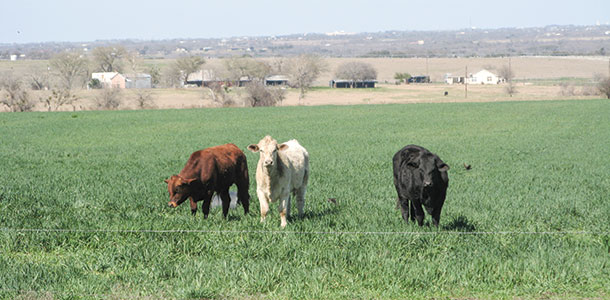 “Animal losses most often involve the respiratory tract and result from one or more diseases within the bovine respiratory disease complex (BRDC),” continues Whittier.
“Animal losses most often involve the respiratory tract and result from one or more diseases within the bovine respiratory disease complex (BRDC),” continues Whittier.
“This complex is also known as shipping fever and includes infections such as infectious bovine rhinotracheitis virus (IBR), paraninfluenza 3 (PI3), bovine respiratory syncytial virus (BRSV) and bovine viral diarrhea (BVD). Digestive disturbances – including diarrheal diseases, grain overload, bloat and parasites – represent a second major area of disease loss.”
Cattle health was recognized as one of the top limitations by stocker operators in a University of Arkansas extension survey of 100 Arkansas stocker cattle operations in 2007.
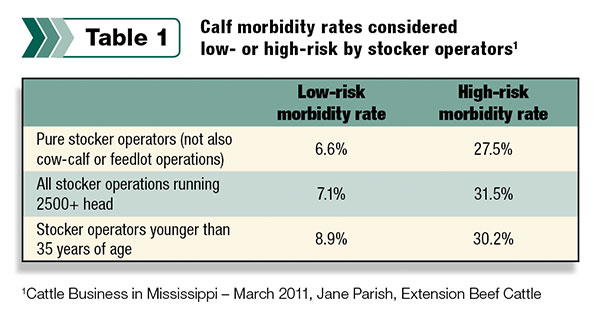 Generally, stocker operators consider 7 percent or less morbidity (illness) to be low risk and 27.5 percent or above to be high risk (Table 1).
Generally, stocker operators consider 7 percent or less morbidity (illness) to be low risk and 27.5 percent or above to be high risk (Table 1).
Research data show 10.3 deaths per 1,000 head of stocker cattle (approximately 1 percent) in 1994 and 17.5 per 1,000 (approximately 2 percent) in 2003. Although the percentages are low, lost values are high considering today’s cattle prices.
“Veterinary medicine has primarily concentrated on pathogens,” says Thomas Hairgrove, DVM, program coordinator for livestock and food animal systems, Texas A&M AgriLife Extension Service.
“Researchers need to increase their attention on immune function and ways that it is obtained. The key to keeping animals healthy is to build their immunities."
“Commingling is the biggest challenge to maintaining immunity in a stocker operation,” Hairgrove continues. “Disease risk is lower in a group of calves purchased from a single producer who has a good herd health program, but risk is higher in a load of calves obtained from multiple producers."
"New arrivals from multiple sources should be quarantined as far away from other cattle as possible, and even more important, work with a local large-animal practitioner to design a health program based on prevalent diseases in the areas where the calves were raised."
“Stress prevention through good stockmanship is very important for maintaining animal immunity,” Hairgrove emphasizes.
“Stress caused from situations such as extreme hot or cold weather, hollering and using force when working or moving cattle, transporting and weaning can all suppress the immune response, making animals more susceptible to pathogens.”
“Stocker calves, especially those on permanent pastures, are at high risk for internal parasites,” says Thomas Craig, DVM, Ph.D., Department of Veterinary Pathology, Texas A&M University.
“Therefore it is essential to treat when they are put on pasture and then repeat treatment one to three months later, depending on the anthelmintic (wormer) used and the grazing season."
"Because these calves are at risk and pastures may be laden with resistant worms, it may be advisable to have your veterinarian check fecal samples two to four weeks after treatment to aid in determining if the anthelmintic actually worked.”
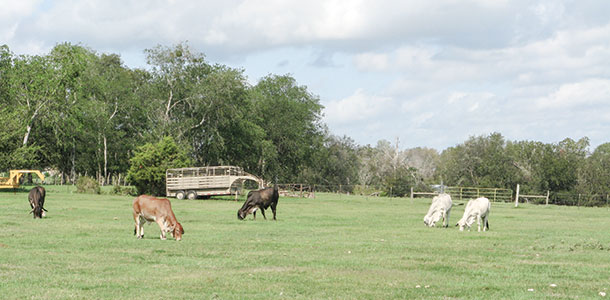 If anthelmintic use is necessary, rotate treatments among classes of active ingredients when acceptable parasite control can be obtained with more than one type of chemical.
If anthelmintic use is necessary, rotate treatments among classes of active ingredients when acceptable parasite control can be obtained with more than one type of chemical.
All currently marketed anthelmintics are labeled for brown and barber pole stomach worm control. In general, the macrocyclic lactones are more likely to be effective against arrested larvae.
There is no efficacy with morantel (Rumatel) or levamisole (Prohibit) against the arrested larval stage, L4 of the brown stomach worm.
Resistance to the barber pole worm has been seen in stocker calves to both benzimidazole and macrocyclic lactones whereas levamisole was effective. There is a great deal of variability in the effectiveness of several ivermectin pour-on products on worms, whereas the injectable products are largely effective against all but Cooperia.
“Cooperia, a species of small intestinal worms, infect young cattle up to 18 months old,” says Craig. “They may be controlled by fenbendazole (Safe Guard and Panacur) or other benzimidazoles, levamisole or morantel.
Regardless of the treatment, Cooperia are hard to control, partly due to the age of animals that require treatment. Fortunately, they generally have fewer long-term effects on cattle production.”
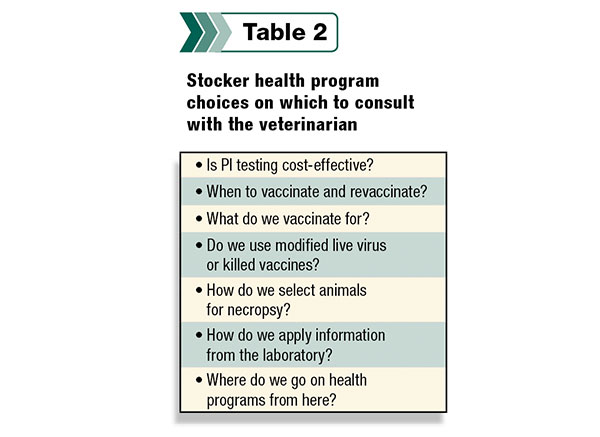 As shown in Table 2, there are a lot of choices to make in managing the health of stocker cattle. If extension livestock specialists were questioned on the right choices, they would probably answer, “It depends.”
As shown in Table 2, there are a lot of choices to make in managing the health of stocker cattle. If extension livestock specialists were questioned on the right choices, they would probably answer, “It depends.”
The reason for that answer is that each situation is different and a local veterinarian who knows your operation can offer the best advice.
The most important practice in animal health is to establish a rapport with a local large-animal veterinarian.
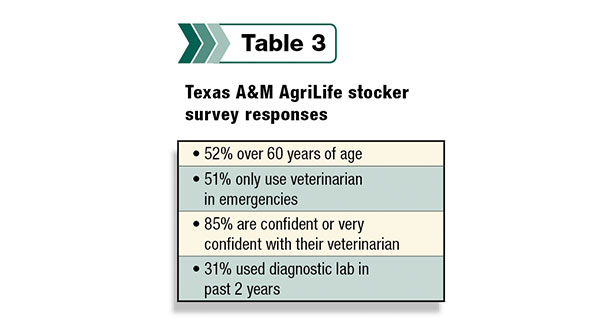 According to the data in Table 3, a large percentage of stocker operators only contact a veterinarian in the event of an emergency.
According to the data in Table 3, a large percentage of stocker operators only contact a veterinarian in the event of an emergency.
Federal government restrictions on drug use
“Because of the theoretical risk of antibiotic-resistant bacteria in food animals becoming a human health problem, the U.S. Food and Drug Administration (FDA) placed restrictions on the use of antibiotics in livestock,” says Virginia Fajt, DVM, Texas A&M University.
“They issued a Veterinary Feed Directive (VFD) that permits the use of antibiotics in feed, but only with veterinarian oversight. Most animal pharmaceutical companies are voluntarily withdrawing their antibiotics from over-the-counter (OTC) sales and putting them under the directive."
"They are also removing the growth promotant use from their product labels. Ionophores, such as Rumensin, Bovatec and Cattlyst, are currently available OTC as growth promotants, since they are not used in human pharmaceuticals.”
“A drug approved for use in or on animal feed as a VFD drug is limited to use only under the professional supervision of a licensed veterinarian,” says the FDA.
“A veterinarian, operating within the confines of a valid veterinarian-client-patient relationship, examines and diagnoses animal conditions and determines whether a condition warrants use of a VFD drug. If it does, the veterinarian will issue a signed VFD order containing information specified by regulation."
"Extra-label use of a VFD drug (or any drug) in or on an animal feed is strictly prohibited. The veterinarian keeps a copy of the VFD order and provides the completed, signed original with a copy to the client. The client keeps the copy and gives the original to the feed manufacturer supplying the VFD feed.”
Antibiotics can still be applied in livestock drinking water as long as a prescription is written by a veterinarian who has a relationship with the client and examines and diagnoses animal conditions. Dosage on the prescription cannot be changed unless a different disease is diagnosed.
Consumer concerns over animal welfare and food production
Special-interest groups will continue to put pressure on Congress to pass more legislation that puts additional restrictions on drug use in livestock.
Additional restrictions will present greater challenges to the stocker operator. We must continue to educate consumers on the necessity of animal pharmaceuticals in producing a wholesome safe product.
“Supply chains can potentially influence the stocker operator’s future,” says Hairgrove. “Consumers will continue to voice their concerns over animal welfare, antibiotic resistance, hormones and other management practices to their grocery retailers. This can cause food distributors and processors to place more stringent purchase specifications on producers.”
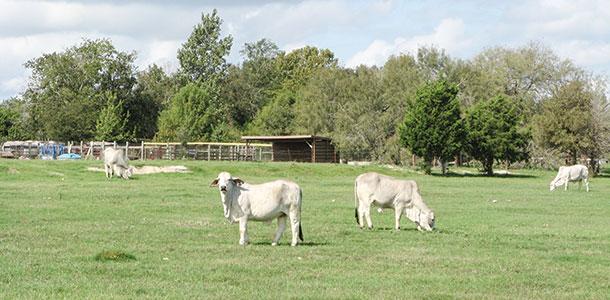 Follow the National Cattleman’s Beef Association Beef Quality Assurance Guidelines on preventive medicine and animal stress prevention. Ask your veterinarian to keep you informed on new FDA regulations that will affect your operation.
Follow the National Cattleman’s Beef Association Beef Quality Assurance Guidelines on preventive medicine and animal stress prevention. Ask your veterinarian to keep you informed on new FDA regulations that will affect your operation.
“Strictly adhere to label directions, particularly injection sites,” cautions Hairgrove. “One of the antibiotic labels contains explicit directions on where to inject a product in the animal’s ear with an accompanying diagram, yet people often inject it on sites other than the one specified."
"The ear was selected as an injection site so that residues don’t get into the muscle or meat. Consumers don’t eat beef ears; therefore residues in ears will not be consumed. Do not compound or mix drugs.”
Stocker operators face many challenges, but they will be minimized with good stockmanship and stewardship. ![]()

Robert Fears is a freelance writer based in Texas.
PHOTOS
PHOTO 1: Commingling is the biggest challenge to maintaining immunity in a stocker operation
PHOTO 2: Stocker calves on winter pasture.
PHOTO 3: The key to keeping animals healthy is to build their immunity.
PHOTO 4: Try to learn the history of cattle you buy. Photos courtesy of Robert Fears.







